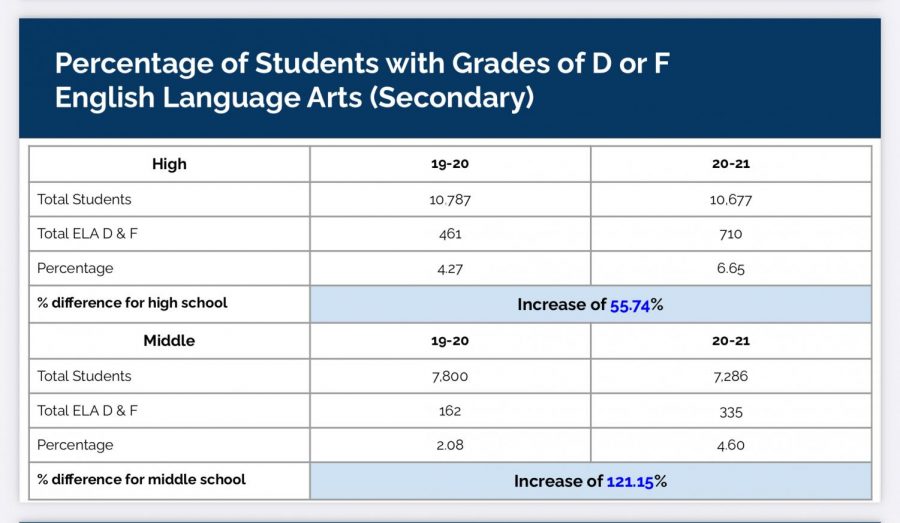Number of students failing English, math soars with remote learning
High school students failing English jumped 124% during online school last fall
District figures show that the number of high school and middle school students who earned a F or D in English skyrocketed last fall, compared to the first semester of the 2019-20 school year.
Too much screen time and a greater difficulty to focus during class aren’t the only problems that have arisen with online learning.
The fast growing number of failing students in key academic classes has become a prevalent problem as well.
During the first semester of the 2020-2021 school year, the number of high school students failing their English class has skyrocketed by nearly 125 percent compared to the first semester of 2019-2020, according to figures released at the San Ramon Valley Unified School District’s Jan. 12 Board of Education meeting.
First semester grades show that the number of students failing English has increased 124 percent, jumping from 141 F’s in the 2019-20 school year to 311 F’s this past fall. The number of D’s in English also shot up 25 percent, from 320 to 399 this semester. Assistant principal Jeffery Osborn stated in an email that Cal High was not comfortable sharing school-specific data.
“Most students aren’t really prepared to do online work,” English teacher Devan Manning said.
Although not as drastic, the number of high school students failing math increased 14 percent last semester, with 308 students getting an F compared to 270 in the first semester of the 2019-20 school year, according to district figures.
Conversely, district figures show that there was a 17 percent decrease in students earning a D in math in the first semester of 2020-21. Only 463 students earned a D in the fall, compared to 564 in the first semester of 2019-20.
Manning believes that most of the reasons students are failing can be narrowed down to the fact that online school came mostly out of nowhere, and it’s a monumental change. English teacher Donna Montague agreed and believe that some teachers are not prepared for the vast differences present in online learning, as opposed to conventional schooling.
“Teachers need to be more aware that learning online is different than learning in person,” Montague said.
Montague said some old teaching methods don’t translate well over to online school, and these strategies can cause inefficient or faulty learning for some students. To add to this problem, students also have a tendency to turn in late or lackluster work in a remote environment, which can cause their grades to drop drastically as well.
Some students have theories on why people may be getting worse grades in English compared to other classes.
“It could be due to a lack of students paying attention,” said sophomore Inder Brar, who has seen instances where his fellow classmates simply aren’t focusing on what the teacher is saying.
This, he says, can cause students to be confused and disorganized when it comes time to complete an assignment using the information they have learned.
Some students believe lessons taught in a tradition, in-class setting are just more effective. Senior Rachana Balakrishnan said some of the nonverbal cues that teachers may have used in the past to accentuate some points of learning or help students understand information are lost when lessons are taught on Zoom, causing many students to struggle learning the materials as a result.
“It’s harder to give lessons on Zoom,” Balakrishnan said.
Although the data shows that not as many students are finding it more difficult to learn in online math classes, some students seem to disagree with this conclusion.
“In online school, it is definitely way harder to learn new information,” said sophomore Josh Chandran, noting that math has become significantly more difficult as the school year as wore on.
Cal High AP Statistics teacher Ghazala Niazi said she has observed no significant difference in the number of students earning D’s or F’s in her classes. She thinks that the less-monitored system of online learning may actually open the door for students to use outside help to augment their normal capabilities.
“Students have access to additional resources to support their work even on tests and quizzes,” Niazi said.
High school students are not the only ones negatively affected by remote learning in these two subjects.
District figures also show that the number of middle schoolers failing English jumped nearly 253 percent with 127 students earning an F last semester, compared to only 36 students during the same time of the 2019-20 school year. The number of D’s in English also rose 65 percent, with 208 students earning a D last fall compared to 126 students the previous year.
In math, the number of middle schoolers failing during the first semester of remote learning rose 152 percent with 249 students earning an F compared to 99 students in the fall of 2019-20. The number of D’s in math also increased by 17 percent, with 265 students earning a D compared to 226 students during the first semester of 2019-20.
Despite the lack of preparedness for online learning that seems to have caused the increase in low grades, Manning still believes that this was no one’s fault, as the unexpected closure of school due to COVID-19 was not something people could predict or prevent.
Manning and other teachers hope that this can be used as a learning experience for most students and teachers, and that the district can find better ways to integrate online activities and lessons into education.

Senior Rohan Iyer is a staff writer for the California High school newspaper. This is the second time he has taken part in The Californian paper as a writer,...










